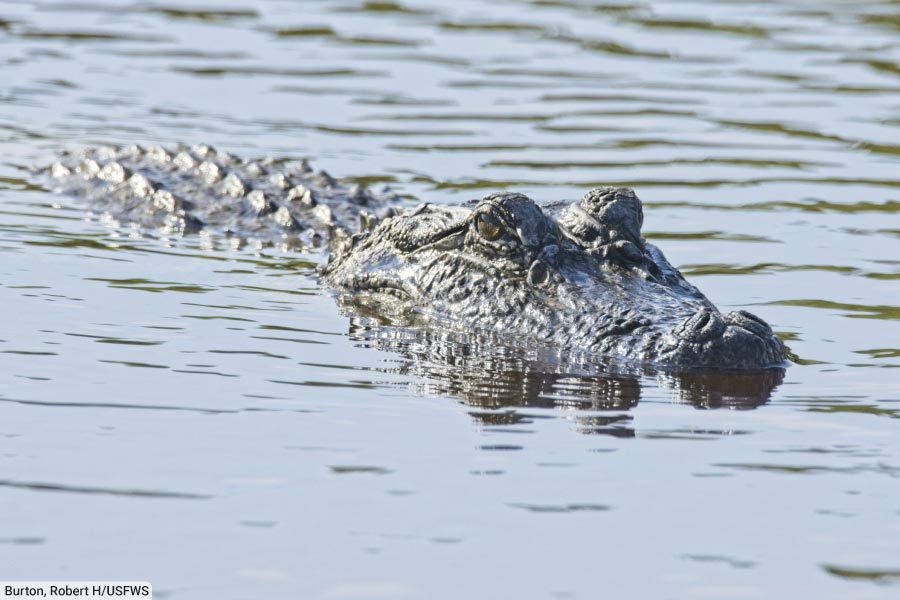Alligator vs crocodile – what are the differences between alligator and crocodiles and how can you identify which is which?
Alligators & Crocodiles

Alligators and crocodiles share many similarities; both are carnivorous, semi-aquatic reptiles belonging to the order Crocodilia, an ancient reptile group that is also home to caimans and gharials.
Although alligators and crocodiles are alike in many ways, there is a reason that scientists have separated them into two different families.
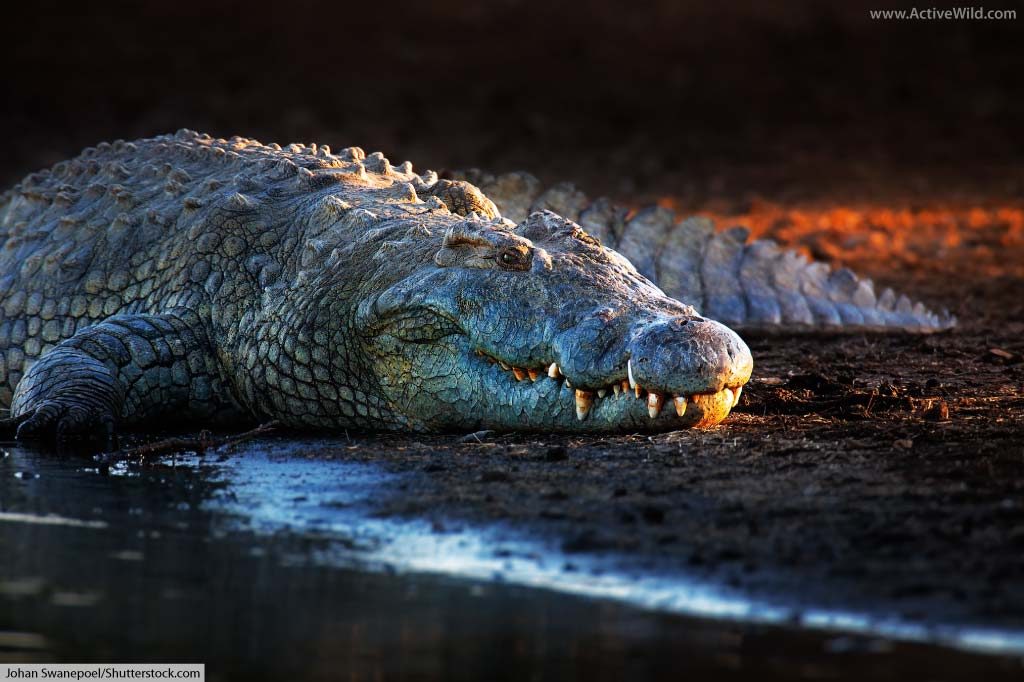
A comparison of alligator vs crocodile reveals numerous physical differences (listed below) between the animals of each group; a result of the tens of millions of years of evolution that separates them.
Scientists believe that the ancestors of today’s alligators and crocodiles diverged around 80 million years ago, during the Late Cretaceous Period – a time when dinosaurs still walked the Earth.
Below is a list of the main differences between alligators and crocodiles…
Alligator vs Crocodile Differences
- Snout Shape: Alligators typically have a broader and U-shaped snout, while crocodiles possess a more pointed and V-shaped snout.
- Teeth Visibility: When an alligator's mouth is closed, usually only its upper teeth are visible as they overlap the lower teeth. In contrast, when a crocodile's mouth is closed, both its upper and lower teeth are visible, since they interlock.
- Color: In terms of color, alligators are usually darker, with a blackish-grey hue, while crocodiles are generally lighter, often displaying an olive or tan coloration.
- Habitat: Alligators primarily inhabit freshwater environments like swamps, lakes, and slow-moving rivers, in both the southeastern U.S. and eastern China. Crocodiles are better able to tolerate salt water, and some species inhabit brackish water or even marine habitats. Their greater tolerance for saltwater is due to specialized salt glands on the tongue that excrete excess salt. Alligators can exist in slightly a cooler climate than crocodiles, which are found in tropical regions.
- Geographical Distribution: Geographically, alligators are found in the southeastern United States and eastern China. Crocodiles have a wider distribution, being located in various parts of the world including Africa, Asia, the Americas, and Australia, depending on the species.
- Aggressiveness: Alligators are generally more docile towards humans and less prone to unprovoked aggression, whereas crocodiles have a reputation for being more aggressive and pose a greater danger to humans.
- Hide Pores: Integumentary Sense Organs (ISOs) are small sensory pores found on the hides of both alligators and crocodiles. They are thought to detect changes in water pressure. Alligators only have ISOs around their jaws, while crocodiles have them all over the body.
- Number Of Species: There are just two alligator species: the American Alligator (Alligator mississippiensis), and the smaller Chinese Alligator (Alligator sinensis). In comparison, eighteen crocodile species are currently recognized. (Source: the Reptile Database) (note: this figure includes the False gharial, which, although listed in the Reptile Database as being a member of the crocodile family, is now thought by some biologists to be a member of the gharial family, Gavialidae.)
- Family: Alligators belong to the family Alligatoridae (which also contains caimans). Crocodiles belong to the family Crocodylidae.
Crocodile vs Alligator Size
The largest alligator, the American alligator, grows to lengths of around 3.35 to 4.57 m / 11-15 feet. While larger than most crocodiles, there are several crocodile species that surpass the alligator in size, including the Nile crocodile and the saltwater crocodile, both of which reach (and, in the case of the saltwater crocodile, exceed) lengths of up to 6 m / 19.7 ft.

The American crocodile, which coexists with the American alligator in the Everglades of southern Florida, has a larger maximum size, but on average is a similar size to the alligator.
Where Do Alligators and Crocodiles Live Together?

The only place in the world in which alligators and crocodiles live together in the wild is the Florida Everglades, where both the American alligator and the American crocodile are found.
Even in the Everglades, however, alligators and crocodiles seldom meet, each having its own habitat preferences. (Crocodiles are better able to live in saltwater habitats and prefer a tropical climate, whereas alligators are confined to freshwater habitats, and are able to live in a slightly cooler climate.)
The presence of both species in the Everglades can be used as an indicator of the health of the ecosystem (source).
Crocodilians
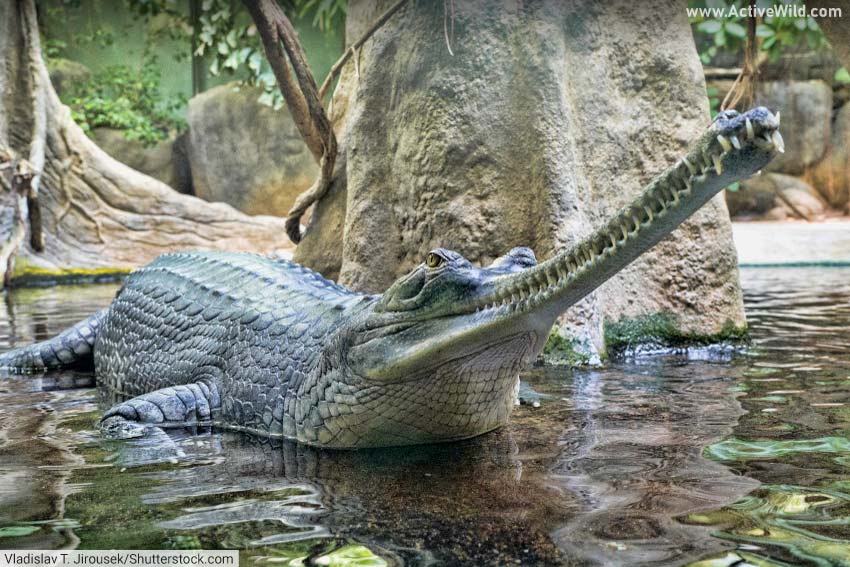
Crocodilians are a group of large, semi-aquatic reptiles that make up the order Crocodilia (also spelled Crocodylia).
Encompassing 27 species (source) and spanning three distinct families—Crocodylidae (true crocodiles), Alligatoridae (alligators and caimans), and Gavialidae (gharials)—these ancient predators have roamed the Earth for over 200 million years, with their present-day forms showing remarkable similarity to their prehistoric ancestors.
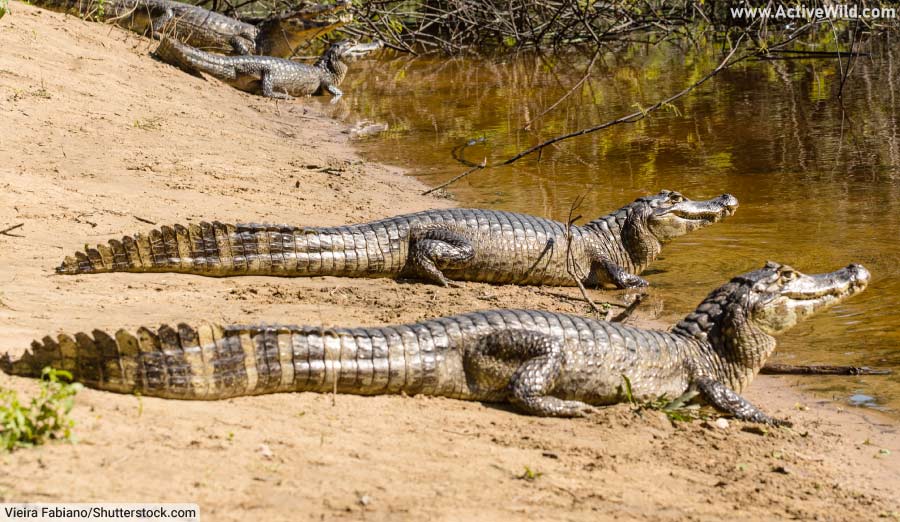
Distributed across the tropics and subtropics, crocodilians are well-adapted to a life in water, possessing powerful tails for swimming, and eyes and nostrils positioned on top of their heads to allow for submerged hunting.
Known for their formidable size and strength, many crocodilians are apex predators, playing a critical part in maintaining the ecological balance of their respective habitats.
While often feared by humans, many species are now threatened or endangered due to habitat loss, hunting, and human conflict, making conservation efforts vital for their survival.
Crocodiles
Crocodiles are carnivorous reptiles belonging to the family Crocodylidae, one of the main branches of the larger group, crocodilians.
With a lineage dating back over 85 million years, these prehistoric-looking creatures can be found in freshwater habitats like rivers, lakes, and wetlands across the tropics and subtropics. Better able to deal with saltwater than alligators, some crocodile species are also found in brackish (i.e., a mix of freshwater and saltwater) habitats.
Characterized by their long, V-shaped snouts, armored skin, and powerful jaws, many crocodile species are formidable apex predators, playing a pivotal role in maintaining the ecological balance of their environments.
Though often feared for their size and strength, crocodiles are complex creatures with fascinating behaviors, including intricate social structures and maternal care.
Saltwater Crocodile
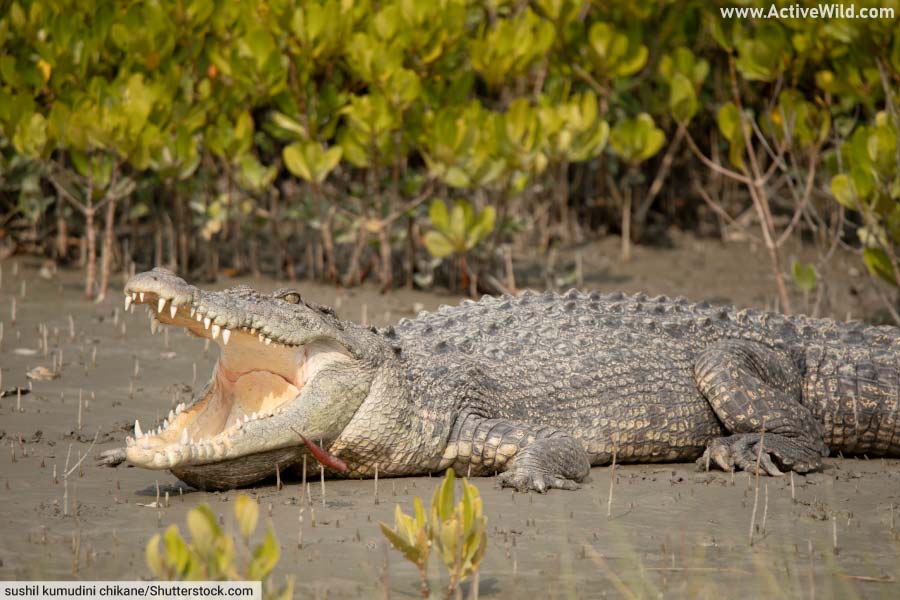
The world’s largest crocodile, the saltwater crocodile, is also the world’s largest living reptile. This huge predator reaches lengths of over 6m, and can weigh over 1.5 tons (3,300 lb.), and is found in Southeast Asia and Australia. As its name suggests, it is found in marine habitats, but it also inhabits brackish and freshwater habitats.
You can find out more about the saltwater crocodile on this page: Saltwater Crocodile Facts
Nile Crocodile

The Nile crocodile (Crocodylus niloticus) is a large and iconic reptile native to freshwater habitats in sub-Saharan Africa.
Recognized by its robust build and long V-shaped snout, this crocodile can reach lengths of up to 6 m / 19.7 ft., making it the largest freshwater predator in Africa. Its tough, armored skin exhibits a dark bronze coloring, with darker cross-bands scattered across its back and tail.
An apex predator, the Nile crocodile feeds on a variety of prey, from fish and birds to larger mammals that come close to the water's edge. Notorious for its ambush hunting technique, it waits patiently beneath the surface near the water's edge, ready to strike with immense speed.
The Nile crocodile’s fearsome reputation is well deserved; the species is responsible for a significant number of fatal human attacks each year, often resulting from people venturing too close to its habitat.
You can find out more about the Nile crocodile on this page: Nile Crocodile Facts
Alligators
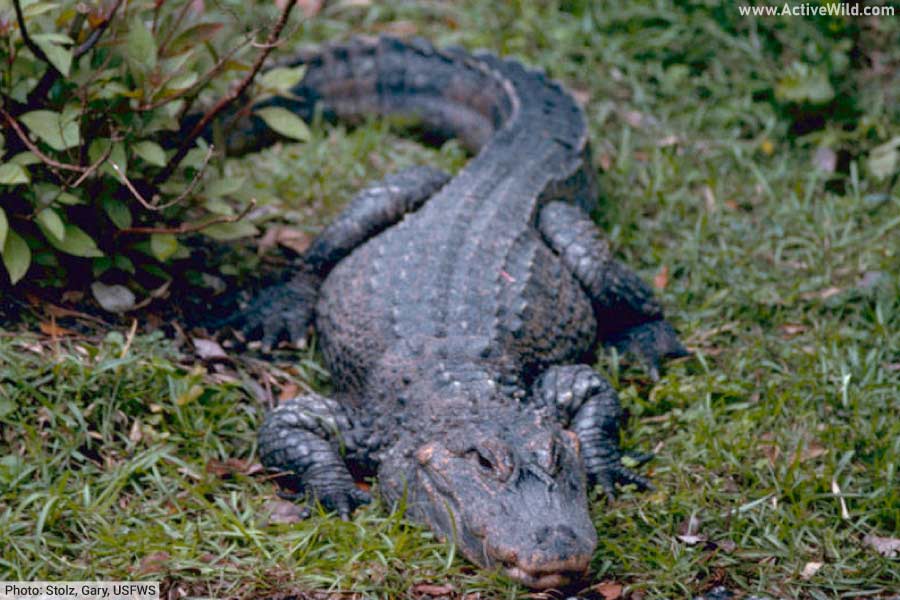
Alligators are large, semi-aquatic reptiles belonging to the genus Alligator within the family Alligatoridae.
Alligators are characterized by their broad, U-shaped snouts, armored bodies with rows of bony plates called osteoderms, and powerful tails. They are found in freshwater habitats such as swamps, marshes, rivers, and lakes.
Two distinct alligator species are recognized: the American alligator (Alligator mississippiensis), which is found throughout the southeastern United States, and the smaller Chinese alligator (Alligator sinensis), native to the Yangtze River basin in China.
The Chinese alligator is critically endangered, with under 100 mature individuals thought to be alive in the wild. (More Chinese alligators are found in captivity than in the wild.)
You can see more critically endangered animals on this page: Critically Endangered Species
Alligators are opportunistic feeders, consuming a wide variety of prey ranging from fish and birds to larger mammals. Notably, they differ from crocodiles in appearance, habitat preference, and behavior, with a more rounded snout and typically a darker coloration.
While they can be dangerous to humans if provoked or if their territory is threatened, alligators are generally less aggressive than their crocodile counterparts. Over the years, conservation efforts have been crucial in protecting alligator populations, particularly for the once-endangered American alligator.
American Alligator
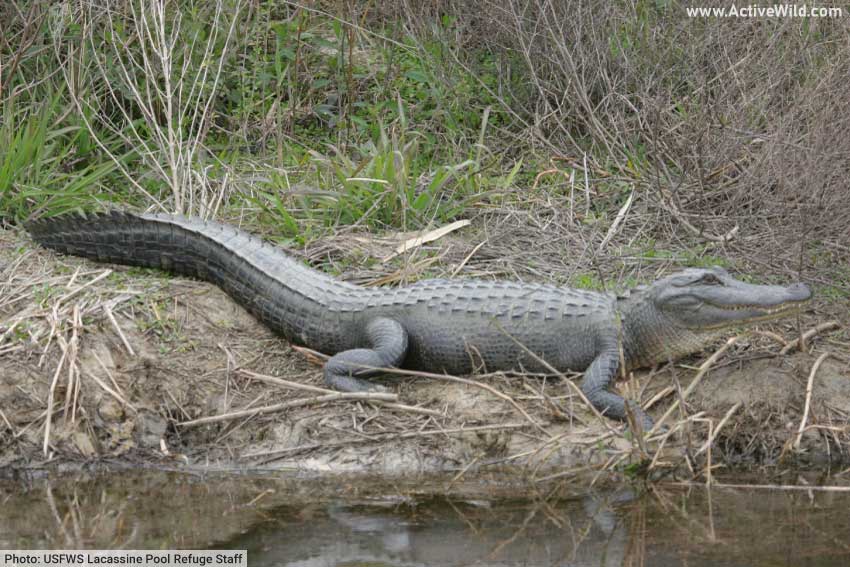
The American alligator (Alligator mississippiensis) is a large reptile endemic to the southeastern United States. Characterized by its broad, U-shaped snout, dark olive-brown armored body, and powerful tail, it primarily inhabits freshwater ecosystems such as swamps, marshes, rivers, and lakes.
Adult male American alligators can reach lengths of up to 4.6 m / 15 feet, though averages are closer to 3.35m / 11 feet. As opportunistic predators, American alligators have a varied diet, consuming everything from fish and birds to mammals and smaller reptiles. They are known for their ability to thrive in both natural and human-made freshwater systems and can sometimes be spotted basking on riverbanks, lakeshores… and even next to water hazards in golf courses!
Once an endangered species due to hunting and habitat loss, concerted conservation efforts in the 20th century have led to a significant rebound in the American alligator population, and the species is now classified as Least Concern by the IUCN.
You can find out more about the American alligator on this page: American Alligator Facts
You can find out more about the American crocodile on this page: American Crocodile Facts
Discover More With Active Wild
You can find out more about crocodilians, reptiles, and other animals on the following pages:
Visit our main animals page for links to animal information and a complete guide to the animal kingdom: Animals
You can find out more about reptiles on this page: Reptiles – The Ultimate Guide
Discover different types of reptiles on this page: Types of Reptiles

